Written and photographed by Mary L. Peachin
Vol. 11 No. 7
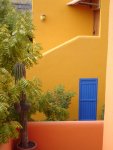 After a day of diving and fishing offshore Cabo San Lucas, I asked the guide to drop me in the surf. I could easily swim to shore from the panga. That turned out not to be the case. Several decades ago, not too many people were aware of a serious rip tide that makes the majority of Cabo’s surf unsafe to swim. I finally managed to haul myself and dive gear up the beach to the Hotel Cabo San Lucas, one of the few places built along the beach.
After a day of diving and fishing offshore Cabo San Lucas, I asked the guide to drop me in the surf. I could easily swim to shore from the panga. That turned out not to be the case. Several decades ago, not too many people were aware of a serious rip tide that makes the majority of Cabo’s surf unsafe to swim. I finally managed to haul myself and dive gear up the beach to the Hotel Cabo San Lucas, one of the few places built along the beach.
Times have changed and Cabo is no longer the sleepy village of the past. Today, it is lined with one luxurious resort after another. Recently, I had the opportunity to experience a unique adventure (for me); one that offered both luxury and charm in nearby Todos Santos, a small artist colony located on the Pacific Ocean side of the Cape.
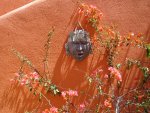 Todos Santos dates back to 1724 when Spanish Jesuits built a small visita at Mission Santa Rosa de Todos Lo Santos. A decade later, the outpost became a full-fledged mission.
Todos Santos dates back to 1724 when Spanish Jesuits built a small visita at Mission Santa Rosa de Todos Lo Santos. A decade later, the outpost became a full-fledged mission.
Spanish epidemics decimated the Indian population, and by 1749, Todos Santos or “All Saints” was abandoned. In the late 19th century, the village was inhabited by plantation farmers who milled sugar cane until the aquifer was depleted. Today, the village is considered an artist’s colony.
 Posada La Poza, which translates to “Inn at the spring” is located at the end of a rugged winding road. The place is the personal creation of Swiss-born Juerg Wiesendanger and his Czech wife, Libusche. Opened in 2002, La Poza’s secluded setting, an hour north of Cabo San Lucas, overlooks a bird sanctuary lagoon which is separated by a small sandbar from the Pacific Ocean
Posada La Poza, which translates to “Inn at the spring” is located at the end of a rugged winding road. The place is the personal creation of Swiss-born Juerg Wiesendanger and his Czech wife, Libusche. Opened in 2002, La Poza’s secluded setting, an hour north of Cabo San Lucas, overlooks a bird sanctuary lagoon which is separated by a small sandbar from the Pacific Ocean
Totally isolated, the inn’s seven intimate suites, so far removed from the bustle of today’s world, offers every comfort. It is truly an escape for some “time out”.
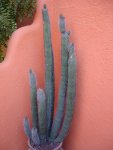 Natural springs plummet down towering Sierra de la Laguna 6,000 foot range to surface beachfront along the arid Baja desert on La Poza’s four acres. The fresh water has created a lush, palm-studded oasis filled with as many as 70 species of birds: migrating Canada geese, snowy egrets and belted kingfishers, and more. During winter months, beyond the wave break, gray whales, many with calves, swim along the endless stretch of uninhabited beaches that extends two miles southward and 500 miles northward.
Natural springs plummet down towering Sierra de la Laguna 6,000 foot range to surface beachfront along the arid Baja desert on La Poza’s four acres. The fresh water has created a lush, palm-studded oasis filled with as many as 70 species of birds: migrating Canada geese, snowy egrets and belted kingfishers, and more. During winter months, beyond the wave break, gray whales, many with calves, swim along the endless stretch of uninhabited beaches that extends two miles southward and 500 miles northward.
No telephones or television disturb the serene ambiance of La Poza, only bird calls and pounding waves of the surf break the silence. Binoculars are provided for each guest to observe the birds from either the beach or a wooden palo de arco latilla-shaded two-story deck.
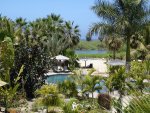 Surrounding the lagoon, La Poza gardens are a botanical wonder of desert flowers and blooming cactus. Some the plants include the giant golden cup, an indigenous yellow flower “tuna” prickly pear, barrel cactus, blue agave, day lilies, roses, and century plants. Queen, blue bismarcia, king, and coconut are a few species of palm. To enhance the garden’s fragrance, there is hibiscus, oleander, bird of paradise, frangipani, and jasmine. Guave, pomegranate, grapefruit, avocado, pistachio, lychee nuts, fig, mango, papaya, date, rosemary, basil, yerba buena or mint, bananas, and macadamia nuts-all used as ingredients in by the kitchen. Euphorbia, succulents, and indigenous saguaro-like cardon are everywhere.
Surrounding the lagoon, La Poza gardens are a botanical wonder of desert flowers and blooming cactus. Some the plants include the giant golden cup, an indigenous yellow flower “tuna” prickly pear, barrel cactus, blue agave, day lilies, roses, and century plants. Queen, blue bismarcia, king, and coconut are a few species of palm. To enhance the garden’s fragrance, there is hibiscus, oleander, bird of paradise, frangipani, and jasmine. Guave, pomegranate, grapefruit, avocado, pistachio, lychee nuts, fig, mango, papaya, date, rosemary, basil, yerba buena or mint, bananas, and macadamia nuts-all used as ingredients in by the kitchen. Euphorbia, succulents, and indigenous saguaro-like cardon are everywhere.
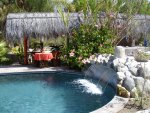 In El Gusto!, Juerg Wiesendanger serves gourmet Mexican cuisine blended with international accents. He uses only organic products. Breakfast might include a hand squeezed orange-banana juice, toast with home made guava jam, a fresh fruit plate, and huevos rancheros. Juerg also shakes one of the finest margaritas on either side of the border. He uses the quality of Centenario Azul (blue agave) tequila, cointreau, and fresh lime–always. He serves it like a martini-chilled, and up. Lunch is served casually on one of two outdoor patios, while dinner is fine dining.
In El Gusto!, Juerg Wiesendanger serves gourmet Mexican cuisine blended with international accents. He uses only organic products. Breakfast might include a hand squeezed orange-banana juice, toast with home made guava jam, a fresh fruit plate, and huevos rancheros. Juerg also shakes one of the finest margaritas on either side of the border. He uses the quality of Centenario Azul (blue agave) tequila, cointreau, and fresh lime–always. He serves it like a martini-chilled, and up. Lunch is served casually on one of two outdoor patios, while dinner is fine dining.
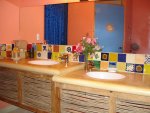 Each room is unique in design with orthopedic mattresses and imported Swiss cotton sheets. Libusche is a professional artist, and her touch is evident throughout the rooms. Walls are faux painted in bright colors, baths have hand-painted murals, and the open air shower is a collage of Mexican tile. There are Dale Chihuly-type and Italian lamp fixtures. In addition to Libusche’s oil canvasses, rooms are accented with pottery, folk art, and artificial plates of edible-appearing fruit. She has created a gallery throughout the Inn; from her garden sculpture and planters to her paintings in the restaurant and every detail in the suites.
Each room is unique in design with orthopedic mattresses and imported Swiss cotton sheets. Libusche is a professional artist, and her touch is evident throughout the rooms. Walls are faux painted in bright colors, baths have hand-painted murals, and the open air shower is a collage of Mexican tile. There are Dale Chihuly-type and Italian lamp fixtures. In addition to Libusche’s oil canvasses, rooms are accented with pottery, folk art, and artificial plates of edible-appearing fruit. She has created a gallery throughout the Inn; from her garden sculpture and planters to her paintings in the restaurant and every detail in the suites.
Guests can enjoy a refreshing saltwater swimming pool and Jacuzzi, or the Temazxal, a traditional Mexican sweat lodge. There is complimentary use of bicycles and fishing gear. A massage can be arranged in a poolside tent, room or on the private beach. Anglers can borrow rods to surf cast for robalo (snook) or sierra mackerel.
Several two-story orange and yellow casitas have garden, lagoon and ocean views. Each suite features a comfortable sitting areas, terrace or patio, mini-bar, safe, spacious bathrooms with tiled walk-in shower and toilet in a separate room, air conditioning, fans, a CD player with choice of music. Several suites include a spa or hot tub.
La Poza is a respite from the frenetic pace of modern life. One where the Wiesendanger’s understanding of every detail is set in a friendly, comfortable environment, almost like being invited friends in their home.
Yes, beyond the galleries of Todos Santos, on a secluded beach, is a very special place, Posada La Poza.
Information and reservations: 011.52.612.145.0400 or [email protected], www.lapoza.com
La Poza is reached by weaving circuitous dirt roads through Todos Santos. La Paz and Los Cabos airports are 60 or 90 minutes away. Rates range from $165.00 to $480.00 a night. The restaurant is closed on Thursdays, and the Inn is closed for the month of September. For safety reasons, no children under 14 are allowed.
